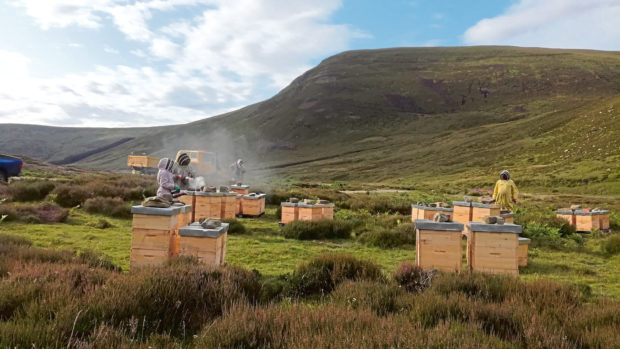Britain’s biggest bee farmer estimates he has about a billion workers on his books – give or take a few tens of millions.
With 4,000 hives scattered around the hills of Aberdeenshire, Perthshire and Angus, each of them containing 40-50,000 bees, Murray MacGregor is the country’s undisputed “heather honey king” and a bulk supplier to the major retailers.
But while the production is up to the yellow and black insects, Murray has a massive logistical job on his hands, and every July he oversees a complex operation which involves transporting colonies from agricultural crops as far afield as Inverurie, Hereford and Cirencester to the hills of Aberdeenshire, Perthshire and Angus.
For three weeks, convoys of yellow Mercedes-Benz Unimogs crawl away from the business base at Coupar Angus at 2am or 3am to pick up the hives before the bees start to fly at dawn. Hive entrances are blocked with foam rubber strips to stop the insects coming out, then the colonies are loaded on to the trucks before the precious cargo is trundled up remote glens to what Murray describes as a “heather banquet”.
“The month the heather flowers is the most important of the year for us as 75% of our annual revenue is generated at that time,” he said.
“We need to get the timing right and do it carefully so as not to upset the bees. But working bees are happy bees – they produce nectar and that helps them with their general wellbeing. If they sit where there’s nothing for them, they become prone to all kinds of stress-related issues and complaints.”
After 40 years in the business – he is the second generation of bee keepers and about to hand over to the third – he has a detailed knowledge of farms, estates and every patch of heather that can provide a site for his ever-growing business.
“Most of them we return to year after year and sometimes estates approach us to take bees to the heather,” he said.
“Bees are good for whole environment – they pollinate all the wild plants and heather which means it produces a bigger crop of berries that the birds and animals like to eat. Everything does better when bees are on the land – they help the balance of nature.”
Heather honey is in demand – and in short supply – around the world, and Scotland is one of the leading producers. Murray says it has an intensity of smell and flavour, but it also has unique properties which aren’t found in other honeys.
“The smell is intense, it’s an orange colour and it is gelatinous honey. We produce it in bulk in steel drums and it is eventually packed in a variety of brands because we don’t have time to do retail,” he said.
Amateur beekeepers have an average of six hives and other bee farmers in the UK run between 40-300 colonies, so Murray’s operation at Coupar Angus is off the scale in this country. He says that means it is difficult to recruit staff with the skills required for commercial beekeeping. He has six different nationalities on the staff and is keen on New Zealanders who, he says, are used to the pace of commercial work.
While business is booming and demand for honey is high, beekeeping has its share of diseases, with Varroa and European Foul Brood two of the most challenging. Murray acknowledges that moving bees around the country lays him open to accusations his work spreads the problems, but he says there are codes of practice he and the wider industry follow closely.
Encouragingly, he says the environment for bees is improving as land management becomes increasingly attuned to the importance of biodiversity, and he is “neutral” about the reduction in chemicals available to agriculture.
“We haven’t seen big pesticide kills since the 1980s, so the environment for bees and chemicals has been improving for quite some time,” he said.
“Modern farmers are well aware bees are their friends, and there’s no point in killing your friend.”
